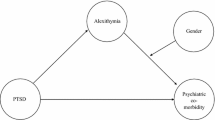Abstract
Alexithymia was measured in non-treatment seeking, community-dwelling Holocaust survivors using the Toronto Alexithymia Scale—Twenty Item Version (TAS-20). Scores of survivors with (n = 30) and without (n = 26) posttraumatic stress disorder (PTSD) were compared, and associations among alexithymia, severity of trauma, and severity of PTSD symptoms were determined. Survivors with PTSD had significantly higher scores on the TAS-20 compared to survivors without PTSD. TAS-20 scores were significantly associated with severity of PTSD symptoms, but not with severity of trauma. This study adds to our knowledge of the relationship between alexithymia and trauma by demonstrating that this characteristic is related to the presence of posttraumatic symptoms and not simply exposure to trauma.
Similar content being viewed by others
References
Antonovsky, A. (1979). Health, stress and coping. San Francisco: Joffrey-Bass.
Bach, M., de Zwaan, M., Ackard, D., Nutzinger, D. O., & Mitchel, J. E. (1994). Alexithymia: Relationship to personality disorders. Comprehensive Psychiatry, 35, 239–243, 1994.
Bagby, R. M., Parker, J. D. A., & Taylor, G. J. (1994a). The twenty-item Toronto Alexithymia Scale-I. Item selection and cross-validation of the factor structure. Journal of Psychosomatic Research, 38, 23–32.
Bagby, R. M., Parker, J. D. A., & Taylor, G. J. (1994b). The twenty-item Toronto Alexithymia Scale: II. Convergent, discriminant, and concurrent validity. Journal of Psychosomatic Research, 38, 33–40.
Blake, D., Weathers, F., Nagy, L., Kaloupek, D., Lauminzer, G., Charney, D., & Keane, T. (1990). Clinician-administered PTSD scale (CAPS-1). National Center for Posttraumatic Stress Disorder. Behavioral Science Division: Boston, Mass.
Hendryx M. S., Haviland M. G., & Shaw D. G. (1991). Dimensions of alexithymia and their relationships to anxiety and depression. Journal of Personality Assessment, 56, 227–237.
Hyer, L., Woods, G. M., Summers, M. N., & Boudewyns P. (1990). Alexithymia among Vietnam veterans with posttraumatic stress disorder. Journal of Clinical Psychiatry, 51, 243–247.
Kauhanen, J. Julkunen, J., & Salonen, J. T. (1992). Validity and reliability of the Toronto Alexithymia Scale (TAS) in a population study. Journal of Psychosomatic Research, 36, 687–694.
Keane, T., Weathers, F., & Blake, D. (1990). The Civilian Mississippi Scale. National Center for Posttraumatic Stress Disorder. Behavioral Science Division, Boston Mass.
Krystal, H. (1988a). Integration and self healing: Affect, trauma, alexithymia. Hilldale, NJ: Analytic Press.
Krystal, H. (1988b). On some roots of creativity. Psychiatric Clinics of North America, 11, 475–491.
Krystal, J. H., Giller, E. L., Jr., & Cicchetti, D. V. (1986). Assessment of alexithymia in post-traumatic stress disorder and somatic illness. Psychosomatic Medicine, 48, 84–94.
McDougall J. (1984). The “dis-affected” patients: Reflections on affect pathology. Psychoanalytic Quarterly, LIII, 386–409.
Nemiah, J. C., & Sifneos, P. E. (1970). Psychosomatic illness. A problem in communication. Psychotherapy and Psychosomatics, 18, 154–160.
Parker, J. D. A., Bagby, R. M., Taylor, G. J., Endler, N. S., & Schmitz, P. (1993). Factorial validity of the 20-item Toronto Alexithymia Scale. European Journal of Personality, 7, 221–232.
Reusch, J. (1948). The infantile personality. Psychosomatic Medicine, 10, 134–144.
Schmidt, U., Jiwany, A., & Treasure, J. (1993). A controlled study of alexithymia in eating disorders. Comprehensive Psychiatry, 34, 54–58.
Spitzer, R. L., Williams, J. B. W., Gibbon, M., & First, M. B. (1990). Structured Clinical Interview for DSM-III-R (SCID, Version 1.0), Washington, DC: American Psychiatric Press.
Swiller, H. I. (1988). Alexithymia: Treatment utilizing combined individual and group psychotherapy. International Journal Group Psychotherapy 38, 47–61.
Taylor, G. J. (1994). Normative data on the TAS-20 for university student, normal adult, and psychiatric outpatient samples. Unpublished, but available from the Author at Department of Psychiatry, University of Toronto and Mount Sinai Hospital, Room 936, 600 University Avenue, Toronto, Ontario, Canada. M5G1X5.
Wise, T. N., Mann, L. S., & Hill, B. (1990). Alexithymia and depressed mood in the psychiatric patients. Psychotherapy Psychosomatics, 54, 26–31.
Zeitlin, S. B., McNally, R. J., & Cassiday, K. L. (1993). Alexithymia in victims of sexual assault: An effect of repeated traumatization? American Journal of Psychiatry, 150, 661–663.
Zietlin S. B., Lane, R. D., O'Leary, D. S., & Schrift, M. J. (1989). Intrahemispheric transfer deficit and alexithymia. American Journal of Psychiatry, 146, 1434–1439.
Author information
Authors and Affiliations
About this article
Cite this article
Yehuda, R., Steiner, A., Kahana, B. et al. Alexithymia in Holocaust Survivors with and Without PTSD. J Trauma Stress 10, 93–100 (1997). https://doi.org/10.1023/A:1024860430725
Issue Date:
DOI: https://doi.org/10.1023/A:1024860430725



